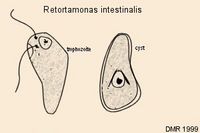Retortamonads
A Microbial Biorealm page on the Retortamonads

Classification
Higher order taxa
Eukaryota; Diplomonadida group
Species
Retortamonas intestinalis
|
NCBI: Taxonomy Genome |
Description and Significance
Retortamonads are a little-studied group of mitochondrion-lacking flagellates which live commensally in the intestines of vertebrate hosts. Research on the genetics of retortamonads has demonstrated a close relationship with members of the diplomad group; the precise implications of this evidence are still in the process of being discussed. The fact that they lack mitochondria has also sparked debates among taxonomists, as to whether ancestrally they have always lacked them, or if they became lost as the organism evolved. Currently projects are underway to determine whether the genome of Retortamonas reveals mitochondrial genes. It is unknown whether retortamonad species differ according to their host. Some authors claim that species of retortamonads may be pathogenic, but because they are difficult to identify and relatively rare, evidence both confirming or disproving this possibility is unavailable.
Genome Structure
The retortamonads and their close relations the diplomonads were hypothesized to be "basal eukaryotes," that is, highly primitive eukaryotes lacking mitochondria. After the genomes of several diplomonads were sequenced, the evidence did not clearly support early divergence of retortamonads and diplomonads. An alternative hypothesis is that these organisms underwent degenerative evolution and lost their ancestral mitochondria. The genome of a retortamonad has not yet been sequenced, but such efforts are underway.
Cell Structure and Metabolism

Retortamonad cells are characterized by obvious cytostomes in the trophozoite, which measures 4-9 microns long. It has a nucleus and two flagella located anteriorly. The cysts are small as well, measuring about 4-7 microns with a prominent nucleus in the center.
The life cycle involves the vertebrate host ingesting water or food contaminated with retortamonad cysts. Inside the host the retortamonads undergo a trophic cycle in which they consume nutrients and become trophozoites, which are able to migrate throughout the host's intestinal tract. These trophozoites replicate asexually, then develop into cysts which are excreted with feces.
Ecology
Retortamonads are commensalistic parasites which live in the intestinal tract of vertebrates. On the rare occasions that it has been identified, they have been found in both warm and temperate climates.
References
Acari, M. et al. The Flagellates. Ectoparasites and Endoparasites. University of Southampton.
Flegr, Jaroslav. Retortamonadida. Faculty of Science, Charles University in Prague.
Parasitology Training Manual: Retortamonas Intestinalis. Practical Science website.
Wiser, Mark F. Intestinal Protozoa. Medical Protozoology, Tulane University School of Public Health.

